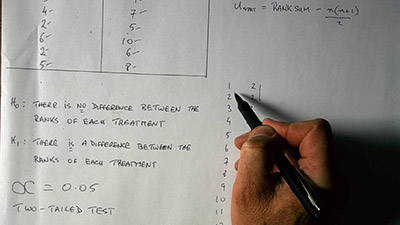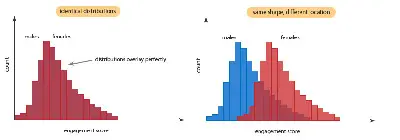The Mann-Whitney U Test
The Mann-Whitney U test is a non-paramedic test that you can use when you don’t want to perform an unpaired t test.
What Is The Mann-Whitney U Test

The Mann-Whitney U test is usually used to test the null hypothesis that two samples come from the same population which means they have the same median. However, you can also perform the Mann-Whitney U test when the observations in one sample are usually larger than observations on a different sample.
Discover the best free online statistic calculators and tables.
How To Use The Mann-Whitney U Test
Let’s say that you have a sample of nx observations {x1, x2, . . . xn} in group 1 from one population, and that you have ny observations {y1, y2, . . . yn} in group 2 from a different population.
According to the Mann-Whitney U test, you will need to compare every single observation xi in the first sample with every single observation xj in the other sample.
The total number of comparisons that you will get is made by nx*ny.
In the case both samples have the same median, this means that every single xi has the same probability of being smaller or greater than each yi.

So, you will need to formulate the two hypothesis:
– The null hypothesis: H0 : P(xi > yj ) = 1/2
– The alternative hypothesis: H1: P(xi > yj ) ≠ 1/2
You will then need to count the number of times where the xi from sample 1 is greater than yi from sample 2 and you will call it Ux.
Then, you’ll need to do the opposite. You will need to count how many times the xi from sample 1 is smaller than yi from sample 2 and you will call it Uy.
According to the null hypothesis, you will nee the Ux and the Uy to be equal or, at least, very close to each other.
Confirm your results by using our Mann-Whitney U Test calculator.
Performing The Mann-Whitney U Test
Step #1:
You will need to order all the observations in order of magnitude.
Step #2:
Look at each observation that you have and signal them as X or Y depending on the sample they are from.
Learn how to calculate mean, median, mode, and range.
Step #3:

Here, you will need to annotate the values for which the xi is greater than the yi as well as the opposite:
– look at the x and write down the number of ys that are smaller than it (or to its left)
– look at the y and write down the number of xs that ate smaller than it (or to it left).
Step #4:
Now, it is time to determine the Ux and the Uy. As we already mentioned earlier, the UX is the total number of times that the xi > yj. Similarly, the Uy is the total number of times that the yj > xi.
At the end, you will need to confirm if Ux + Uy = nx*ny
Step #5:
In this step, you will need to determine the U = min(Ux, Uy).
Step #6:
Now, you will need to have the statistical tables for the Mann-Whitney U test near you. You will need to discover the probability of observing a value U or lower.
In case your test is just one-sided, you will get your p-value. However, in case your test is a two-sided test, then you’ll need to double the probability that you get to determine the p value.
These are the most common probability problems.
Let’s say that you have a tie meaning that you have two or more observations that are the same. In this specific case, you can still determine the U value the same way as before. Nevertheless, you will need to calculate the normal approximation by using an adjustment to the standard deviation.